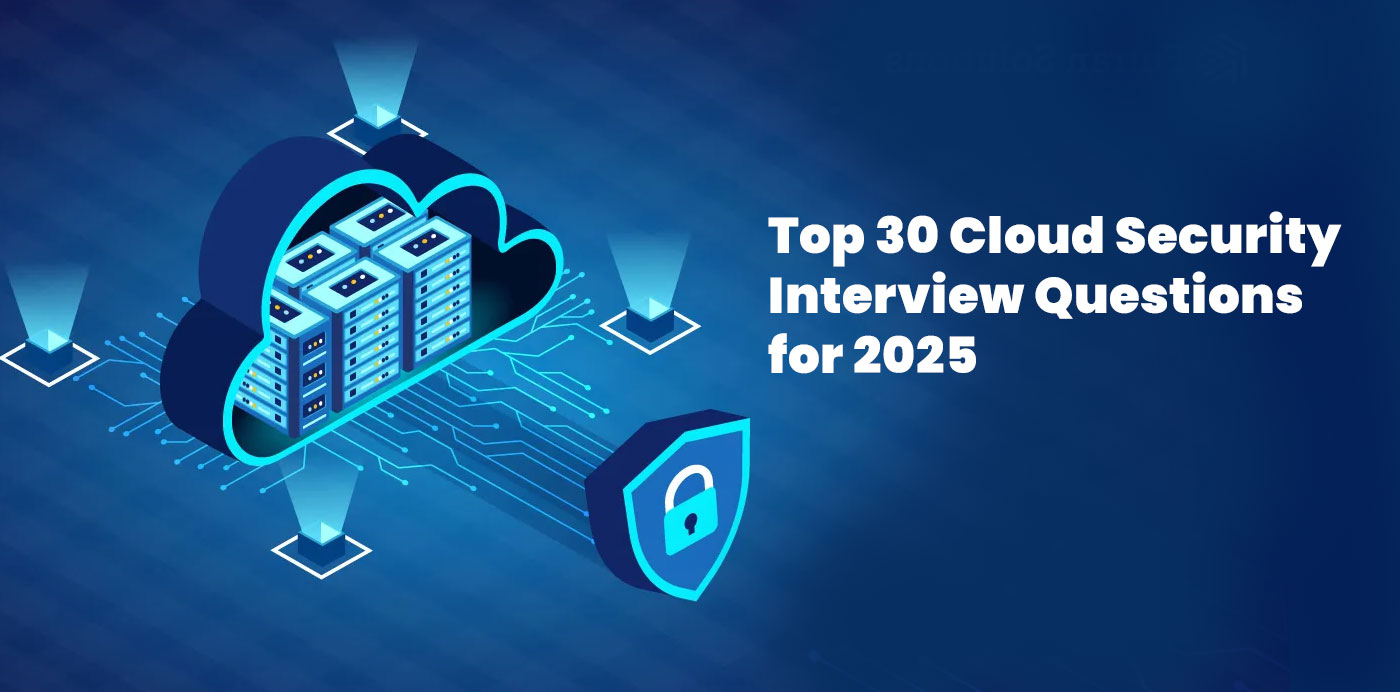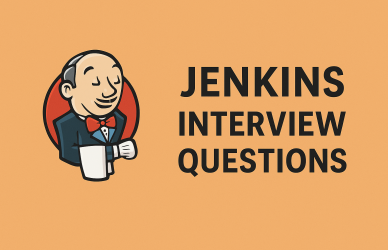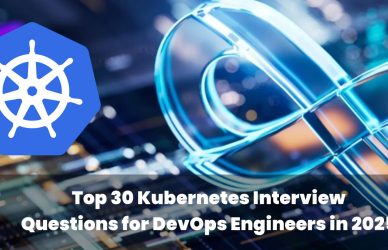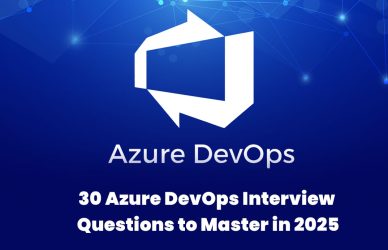Introduction: Why Cloud Security Roles Are Critical in 2025
As cloud adoption reaches 95% in enterprise environments by 2025 (Gartner), organizations are investing more in cloud-native security.
Security engineers are expected to understand cloud provider security services, zero-trust models, identity management, and compliance frameworks across platforms like AWS, Azure, and Google Cloud.
This guide presents the top 30 cloud security interview questions tailored to modern DevSecOps roles and certifications like AWS Security Specialty, Azure Security Engineer, and Google Cloud Security Engineer.
Section 1: Foundational Cloud Security Concepts
1. What is the Shared Responsibility Model?
It outlines which security responsibilities are handled by the cloud provider and which are retained by the customer.
- Cloud Provider: physical security, network, hypervisor
- Customer: data, identity access, workloads, configurations
2. What is Zero Trust Security?
A principle where no user or device is trusted by default, even if inside the network. It enforces:
- Strong authentication (e.g., MFA)
- Least-privilege access
- Microsegmentation
- Continuous monitoring
3. How do you implement Zero Trust in AWS?
- IAM policies and roles
- AWS Organizations + SCPs
- VPC endpoint restrictions
- AWS Cognito or IAM Identity Center
- GuardDuty and CloudTrail integration
4. How do you secure cloud storage buckets?
- Block public access
- Enable encryption (S3, Blob, Cloud Storage)
- Use IAM policies and bucket policies
- Enable logging and Object Lock
5. What is a CASB?
Cloud Access Security Broker — monitors and controls cloud usage across SaaS, IaaS, and PaaS.
Examples: Microsoft Defender for Cloud Apps, Netskope.
Section 2: Platform-Specific Questions (AWS, Azure, GCP)
6. How does AWS GuardDuty work?
A threat detection service that uses machine learning to identify anomalies in:
- CloudTrail logs
- VPC flow logs
- DNS requests
- Login attempts
7. What is the Azure equivalent of GuardDuty?
Azure Sentinel: a cloud-native SIEM that:
- Ingests logs from Azure, hybrid, and third-party services
- Uses AI to detect and respond to threats
- Supports SOAR playbooks via Logic Apps
8. What is Cloud Audit Logging in GCP?
A logging service capturing admin activity, data access, and system events across all GCP services.
Used for compliance and forensics.
9. How do IAM roles differ across AWS, Azure, and GCP?
| Platform | IAM Type | Feature |
|---|---|---|
| AWS | IAM Roles | JSON policies, temporary creds |
| Azure | Role Assignments | RBAC at resource scope |
| GCP | IAM Roles | Predefined, custom, basic roles |
10. What are service principals in Azure?
Identities used by apps and services to authenticate without human involvement.
They’re often assigned permissions in Azure RBAC.
Section 3: Identity and Access Management
11. How do you implement least privilege in cloud environments?
- Assign only necessary permissions
- Use role-based access control (RBAC)
- Audit IAM policies and roles
- Set session duration limits
- Implement access reviews
12. What is MFA and how do you enforce it in AWS?
MFA (Multi-Factor Authentication) adds a second layer of login security.
- Required for IAM users
- Enforce using SCPs in AWS Organizations
- Use hardware or virtual MFA devices
13. How do you manage API key security?
- Store in secret managers
- Rotate keys regularly
- Use IAM roles or OIDC where possible
- Apply least-privilege scopes
14. What is federated identity?
Using an external identity provider (e.g., Okta, ADFS, Azure AD) to authenticate users and allow access to cloud resources via SAML/OIDC.
15. How do you log and monitor IAM activities?
- AWS: CloudTrail, Config, Access Analyzer
- Azure: Activity Logs, Microsoft Defender
- GCP: Audit Logs + IAM Recommender
Section 4: Data Protection & Encryption
16. What is envelope encryption?
A method where data is encrypted using a data key, which is then encrypted with a master key (KMS).
17. How do you manage encryption keys in AWS?
Use AWS KMS with features like:
- Key rotation
- Resource policies
- Customer-managed keys (CMK)
18. What is Azure Key Vault used for?
- Securely store API keys, secrets, and certs
- Integrate with Azure services and RBAC
- Enable logging with diagnostic settings
19. What is Google Cloud KMS?
A managed service to create, rotate, and audit cryptographic keys used for encrypting cloud data (at rest/in transit).
20. What are the differences in key management across cloud platforms?
| Feature | AWS KMS | Azure Key Vault | Google Cloud KMS |
|---|---|---|---|
| Key Rotation | Automatic | Manual/Auto | Manual/Auto |
| Audit Logging | CloudTrail | Azure Monitor | Cloud Audit Logs |
| IAM Integration | IAM Policies | RBAC | IAM |
Section 5: Compliance, Tools & Threat Response
21. How do you ensure compliance (e.g., SOC 2, HIPAA) in cloud?
- Enable config monitoring tools (AWS Config, Azure Policy)
- Use pre-built compliance frameworks
- Automate reports with tools like Prisma Cloud, Wiz, and Lacework
22. What are AWS Security Hub and Azure Defender?
- AWS Security Hub: Consolidates findings from GuardDuty, Inspector, Macie
- Azure Defender: Threat protection for PaaS, VMs, containers
23. What is Macie used for?
AWS Macie uses ML to detect PII and sensitive data in Amazon S3.
Useful for GDPR, HIPAA compliance.
24. What is an Incident Response (IR) playbook in cloud?
A documented response plan triggered when a security event occurs:
Detect → Contain → Eradicate → Recover → Review
Implement automated runbooks (e.g., Lambda, Logic Apps)
25. What is a WAF and how is it implemented?
A Web Application Firewall protects against OWASP Top 10 threats.
- AWS WAF with CloudFront
- Azure WAF with Front Door/Application Gateway
- GCP Cloud Armor
Section 6: Scenario-Based Cloud Cybersecurity Interview Questions
26. You found an open S3 bucket. What steps would you take?
- Block public access
- Enable server-side encryption
- Set strict bucket policies
- Enable CloudTrail logging
- Audit for data exfiltration
27. How do you secure CI/CD pipelines in cloud environments?
- Use secret managers for credentials
- Limit runner privileges
- Scan IaC for vulnerabilities (Checkov, tfsec)
- Sign artifacts
28. A developer hardcoded secrets in Git. What’s your remediation?
- Rotate compromised credentials immediately
- Use GitHub’s secret scanning or Gitleaks
- Educate teams
- Enforce commit hooks to block secrets
29. What are common misconfigurations in cloud security?
- Overly permissive IAM roles
- Public-facing databases
- Disabled logging
- Lack of network segmentation
- No MFA enforcement
30. What are top cloud security certifications for 2025?
- AWS Certified Security – Specialty
- Microsoft Certified: Azure Security Engineer Associate
- Google Professional Cloud Security Engineer
- (ISC)² CCSP
- CompTIA Security+ (entry-level)
Comparison Table: AWS GuardDuty vs. Azure Sentinel vs. GCP SCC
| Feature | AWS GuardDuty | Azure Sentinel | GCP Security Command Center |
|---|---|---|---|
| Type | Threat detection | SIEM + SOAR | Centralized security center |
| Input Sources | CloudTrail, VPC | Logs from any source | GCP logs, VPC, APIs |
| Automation Support | Lambda functions | Playbooks (Logic Apps) | Event Threat Detection API |
| Pricing | Pay-as-you-go | Pay-per-GB ingested | Tiered (Standard/Premium) |
Apply to Cloud Security Roles at CloudDevOpsJobs.com
Ready to put your skills to use?
Explore top-paying security roles at www.clouddevopsjobs.com:
- Cloud Security Engineer (AWS/Azure/GCP)
- DevSecOps Specialist
- Cloud Compliance Analyst
- IAM Architect
- SOC Analyst – Cloud Environments
Set up job alerts and upload your resume today.
Final Thoughts: Master the Cloud Cybersecurity Interview
The cloud security landscape is evolving, and employers want engineers who understand how to defend infrastructure, enforce policies, and automate remediation across platforms.
Use this cloud cybersecurity interview guide to level up your knowledge, ace your interview, and find your next opportunity on www.clouddevopsjobs.com.
Share this on r/cybersecurity or LinkedIn with #CloudSecurity #DevSecOps #CyberInterview2025







